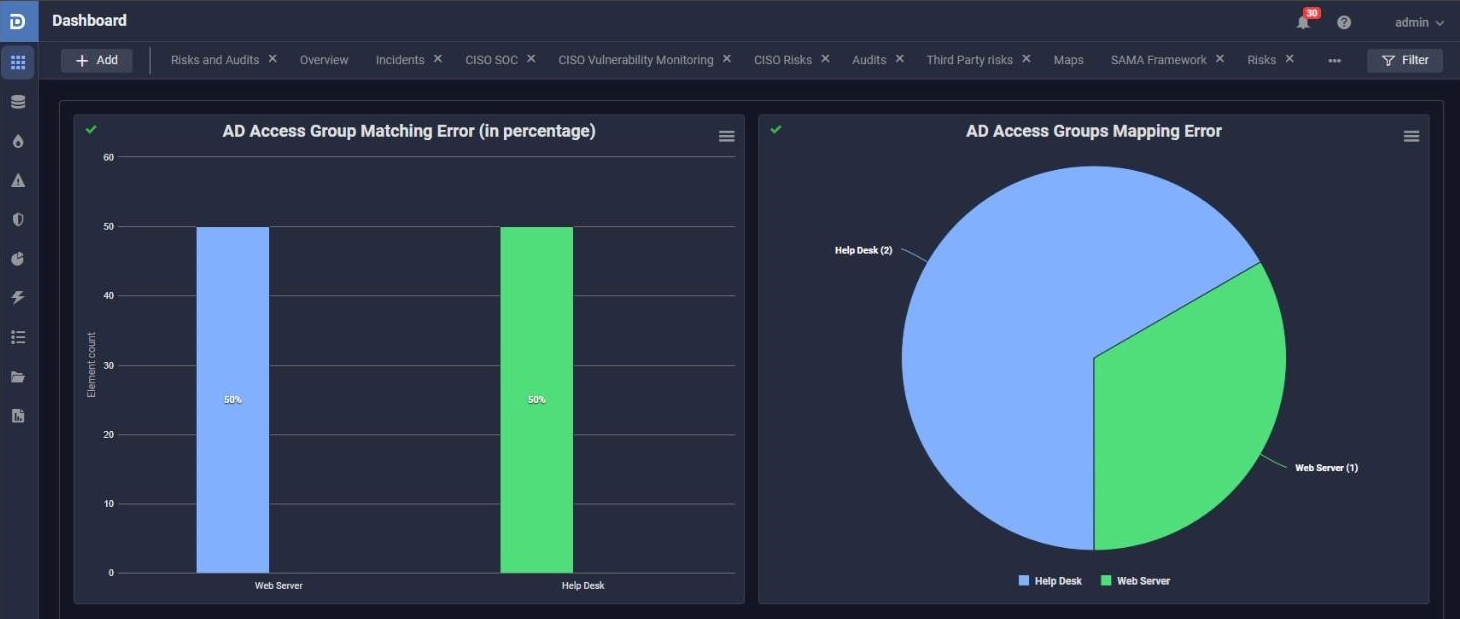19/11/2024

Defensys defines cybersecurity and governance with a comprehensive suite of SGRC tools designed to streamline and automate KPI measurement. Defensys SGRC empowers organizations to enhance their cybersecurity resilience and maintain robust protection against evolving threats.
Automate and Customize Metrics to Fit Your Needs
Defensys SGRC enables seamless automation of KPI calculations across any time period, gathering data from diverse sources to ensure accuracy and relevance. With our platform, organizations can easily implement automated measurements for critical cybersecurity resilience metrics, making it possible to monitor and manage cybersecurity performance in real-time.
Defensys supports a wide range of KPIs to assess compliance, asset protection, and training effectiveness. This flexible functionality allows users to track:
Percentage of antivirus agents successfully installed and reviewed on servers and endpoints.
Percentage of employees completing annual training, including privacy and sensitive data protection practices.
Percentage of policies reviewed annually.
Percentage of network devices not running the latest stable version of security-related updates.
Percentage of network devices lacking a standard, documented security configuration.
Empower Your Risk and Incident Management
Defensys SGRC offers powerful tools for custom reporting in risk and incident management, allowing users to integrate external systems, generate customized data reports, and gain valuable insights on demand. Tailored reporting ensures that decision-makers have immediate access to the metrics that matter most.
With our platform, you can track and report KPIs such as:
Percentage of overdue high-criticality firewall configuration tasks.
Percentage of false positive vulnerability alerts reviewed and analyzed.
Percentage of unresolved critical anomalies or alerts past their deadlines.
Effortless Integration with Existing Systems
Defensys SGRC integrates smoothly with existing systems, including external directories such as Active Directory (AD), to provide a unified view of your cybersecurity landscape. This integration allows for automated updates on employee and account data, ensuring your KPI measurements remain accurate and up-to-date.
For instance, by using this integration you can automatically compare user access groups in AD with reference groups, generating discrepancy reports and suggesting compliance actions for any misalignments detected.
Example of Calculating the Percentage of AD Accounts with Incorrect Access Group Composition
Defensys SGRC provides a streamlined process for identifying and reporting discrepancies in AD account access groups, ensuring compliance with organizational policies and access management standards. The “Access Group (Standard)ˮ asset contains predefined data about users who should belong to specific access groups.

The “Access Group ADˮ asset automatically gathers real-time data from Active Directory, capturing users and groups associated with IT assets.

The system compares the “Access Group Standard)ˮ asset with the “Access Group ADˮ data. If inconsistencies are detected (e.g., unauthorized users or missing members), the field “Identified inconsistenciesˮ is automatically populated for affected access groups, and the checkbox “Access rights errorˮ is checked. These updates allow staff to quickly identify and address access errors without manual effort.
Dashboards display real-time visualizations of affected IT asset groups, highlighting errors at a glance. Staff can directly access filtered lists of affected groups through the dashboard for faster resolution.

Once calculations are complete, you can generate a comprehensive report in the required format, using templates specified by your needs. This report provides a clear breakdown of discrepancies, percentages of affected accounts, and actionable insights for corrective measures.
Example of Calculating KPI for “% of Firewall Configuration High-Criticality Action Plan Items Open Past Deadlineˮ
This KPI tracks the efficiency of managing critical firewall configuration tasks, aiming to minimize overdue items and enhance cyber resilience.
The KPI helps:
Evaluate operational efficiency in handling high-criticality firewall tasks.
Identify bottlenecks and delays.
Support strategic decisions to improve cybersecurity and compliance.
Requirements and Objects for KPI Assessment
Firewall Configurations: Includes all rules and settings controlling network access.
High Criticality Action Plan: Focuses on tasks identified as critical for improving security, requiring prompt implementation.
Completion Timeframe: Predefined deadlines for each task based on its criticality and impact.
Evaluation of Indicators
Delay Cause Analysis: Identify reasons for overdue tasks, such as insufficient resources (staff, tools), lack of automation in task management, miscommunication or unclear priorities.
Impact on Security: Assess risks arising from delays, such as increased exposure to threats, non-compliance with security standards.
Monitoring and Reporting Process
Monitoring Frequency: Conduct evaluations weekly or monthly based on task volume and criticality.
Reporting and Feedback: Generate reports highlighting overdue tasks, causes, and security impacts and share reports with IT teams and management to align on corrective measures.
There is the Firewall Configurations Plan in the “Auditsˮ section of the Defensys SGRC platform.

A detailed view shows the progress of each item in the action plan, including completion status and overdue tasks.

Users can input potential causes for delays in a structured format, ensuring transparency and facilitating analysis. This feature is shown in the interactive dashboard.

A dedicated section allows users to assess and document risks associated with overdue tasks, connecting delays to their impact on cybersecurity.

A summary view of high-criticality tasks highlights overdue items and their current status, helping teams prioritize actions.

Reports are formatted to the userʼs specifications, presenting data on overdue items, delay causes, and potential risks in a concise and professional layout.

Conclusion
The implementation of KPIs, such as percentage of overdue high-criticality firewall configuration tasks, highlights Defensys SGRC robust capabilities in cybersecurity management. By automating monitoring processes, identifying causes of delays, and assessing potential risks, our platform empowers organizations to maintain operational efficiency and enhance cyber resilience.
With features such as integration with external systems, custom reporting, and real-time dashboards, Defensys SGRC streamlines the evaluation and resolution of critical issues. These tools ensure timely completion of action plans, reduce overdue tasks, and mitigate security risks. This approach not only strengthens the organizationʼs defense posture, but also fosters a culture of accountability and continuous improvement in cybersecurity operations.
